How Do Nonprofits Make Money?
How do nonprofits make money?
Nonprofits exist to meet a societal need or provide a public benefit. Unlike an organization whose primary goal is to make money, nonprofits exist to meet a community’s needs. That said, while it’s not your primary purpose, your nonprofit must find ways to make money.
So what are those ways? How do nonprofits make money? Let’s take a look…
Why Do Nonprofit Organizations Need to Make Money?
In reality, nonprofits need to make money to operate, just like any other business.
Your nonprofit may need various sources of income to pay overhead costs, fund its programs, and cover administrative fees. Nonprofits must raise the money to pay rent and salaries while keeping the lights on, just like a grocery store or a law office. The best mission in the world can’t overcome a lack of cash to fund operations and keep programs running.
Of course, it raises an all-important question for leaders: how can your nonprofit make money? There are many ways nonprofits bring in revenue, and the healthiest nonprofits have various income streams. Diversifying sources of income makes it easier to hit budgeting goals, build up reserves, and ensure flexibility in good and bad economic times.
Here are some tips to show you how nonprofits make money and help your organization hit its financial goals.
8 Common Ways Nonprofits Make Money
Individual Donations
One of the most common sources of income for nonprofits is individual donations. And it’s probably the one that comes to mind first, whether it’s the Salvation Army’s Red Kettle Campaign or your local soup kitchen raising funds to feed the less fortunate.
Individual donations are a vital part of the funding for small and large nonprofits, but it is particularly essential for those with operating budgets under $500,000. Research from the Urban Institute found that small nonprofits earn roughly 30% of their income from donations, whereas larger organizations only rely on donations for about 18%.
Given the importance of individual donations, it’s not surprising that nonprofits spend a significant amount of time, money, and energy building a base of donors. Interestingly, one of the most effective ways to do this is to build a robust volunteer program, as engaged volunteers tend to translate into regular donors.
In addition, nonprofits ensure steady income from donations by accepting online donations, creating systems for recurring donations, and soliciting planned giving.
It’s also important to note that donations are tax deductible for most individuals, making this an attractive option for organizations and individuals wanting to support specific missions or efforts.
Corporate Donations
Similarly to individual donations, corporations can also get a tax benefit for donating to 501(c)(3) nonprofit organizations. In fact, a corporation may contribute up to 25% of its taxable income to charitable causes!
And these don’t need to be big, multi-national corporations. Any business in your community can get a tax benefit from giving money to your nonprofit.
Also, many bigger corporations have matching gift programs that match their employees’ donations to nonprofits up to a specific dollar amount, doubling their donation. In addition, other corporations will donate money to you when their employees volunteer with your organization!
Check out the website Double Your Donation to search for participating corporations. It’s an excellent way for your nonprofit to double the money you make without doubling your fundraising efforts.
Fundraising Events
Fundraising events are another crucial part of how nonprofits make money. Most people have participated in a local run or 5k, attended a gala, bid in a silent auction, or seen a pledge-a-thon on TV.
These are all examples of fundraising events that nonprofits hold to earn the revenue needed to run their organization. These events can recur annually, quarterly, or be one-off events, depending on the type of event and the organizational needs.
Besides raising money, fundraising events are also a great way to raise awareness about an organization and its impact on local communities. That said, most fundraising events also take a lot of planning, work, and resources, which is why most nonprofits dedicate a portion of their budget to fundraising efforts.
This sometimes seems counterintuitive to people but is essential to how nonprofits work. Like any business, nonprofits have to spend some money to make money. Fundraising expenses are one clear example of this.
Government Grants
Many large and mid-size nonprofit organizations rely on government grants to make money. In fact, government grants provide up to 10x more money to nonprofits than private foundation grants (see below).
Federal government grants are available, as well as grants at the state and local levels. And you can find grants for all types of nonprofits, from after-school programs to cultural centers, animal welfare organizations, and environmental nonprofits.
Go to Grants.org to look for federal grants relevant to your mission.
Just keep in mind that government grants will require an application, which can be a time-consuming process. You may even need to hire a professional grant writer if it’s your first time.
You’ll also need to have your financial statements up to date. A nonprofit audit may even be a requirement to apply. In addition, government grants often have detailed reporting requirements that you’ll need to submit monthly or quarterly, which creates more paperwork for your accounting team.
We don’t say that to discourage you—many nonprofits rely on government grants to make money for their programs—but you should be prepared that the big payoff will require significant work upfront.
Private Foundation Grants
While government grants may dwarf gifts from private foundations, foundations still gave over $90 billion in 2021, so there is plenty of foundation money to go around!
Some of the most notable nonprofit names you’ve heard of—like the Gates Foundation, The Ford Foundation, and The Robert Wood Johnson Foundation—manage billions of dollars and give away hundreds of millions annually.
Similar to government grants, foundation grants are available for almost any type of nonprofit mission. You can search for available grants in your nonprofit segment at GrantWatch.com.
Private foundations are required to donate at least 5% of their assets every year—so as long as there are foundations, it’s an excellent source for nonprofits to make money.
Earned Income
Many nonprofits have steady streams of earned income, primarily from activities related to the furtherance of their mission. For example, this income can include fees for services, merchandise, memberships, or tickets for performances.
While you often don’t think about this income category for nonprofits, you see it all the time. Any time you buy Girl Scout cookies, purchase a zoo membership, visit an art museum gift shop, attend a symphony concert, or join your local YMCA, you’re helping a nonprofit make money through earned income.
This type of income is essential to how nonprofits make money and is something all leaders should consider. It’s a great way to have a steady income stream while furthering your organization’s mission.
When considering earned income, it’s worth looking at a critical distinction nonprofit leaders have to consider – the difference between related and unrelated business income. Income related to the nonprofit’s activities – for example, a ballet company selling tickets to their performances – is not taxable.
In contrast, income not directly related to the organization’s tax-exempt purpose and occurs regularly—renting out unused building space, for example— is subject to federal income tax.
Corporate Sponsorships and Partnerships
Corporate sponsorships or partnerships can be another abundant source of income for nonprofits. These can range from in-print advertisements to sponsorships of an entire event, in-kind sponsorships, or ongoing cash sponsorships.
The options are varied and depend on the organization, but this type of income primarily focuses on helping a business get brand exposure in exchange for providing nonprofits with income.
It can be an excellent way for nonprofits to make money to cover events or operating expenses. It is also an effective marketing strategy for corporations as they associate their name with important causes in their community. As a result, the corporation gains goodwill in the community, and the nonprofit earns needed income. It’s a classic win-win and essential to how nonprofits earn money.
Investments
One less well-known way that nonprofits make money is through investments.
This type of income isn’t generally for day-to-day operations but is a way leaders can grow long-term savings and build increased reserves. The most common way nonprofits do this is through endowments, where nonprofits accept and then hold donations in an investment fund.
Investments, like stocks, can also be donated by individuals. It’s an attractive way for investors to avoid capital gains taxes and get a significant tax deduction—like when Elon Musk reportedly saved over $4 billion in taxes by donating $5.7 billion in stock to an unnamed nonprofit in 2022.
According to Nolo.com:
If someone owns stock for more than one year that has gone up in value, that person can donate the stock to a nonprofit, get a deduction equal to the fair market value of the stock at the time of the transfer (its increased value), and never pay capital gains tax on the appreciated value of the stock. The nonprofit will never owe that capital gains tax either. It can take the stock and either sell it right away and not pay any tax, or it can hold on to it—but it will never owe capital gains tax on the appreciated value the donor realized.
Many nonprofits will never see a donation of stock, but when it does happen, it could be a money-making windfall for any nonprofit. Every nonprofit should have an established investment policy agreed to by the board of directors, including what to do with donated stock or investments. You may want to hold on to them or liquidate them immediately, but either way, write it into your procedures before you need it.
Investments or endowments are essential for building long-term sustainability for organizations and an effective way to stretch donor contributions as far as possible.
Need Help Managing Your Nonprofit’s Money?
As leaders know all too well, making money is an essential function of every nonprofit. Without steady revenue streams, your nonprofit can’t keep its doors open or meet its organizational goals.
Nonprofits receive money from many different sources, and the accounting can sometimes be complex. They also must be strategic with budgeting to ensure their income covers expenses.
If your team struggles to budget correctly or even properly track and segregate your sources of income, it might be time to consider outsourcing your bookkeeping and accounting.
The Charity CFO helps hundreds of nonprofits nationwide keep updated books, get monthly reporting, stay audit-ready, and manage their money more effectively. In addition, we can help you automate time-consuming practices, implement paper-saving technology, and create bullet-proof systems and processes that allow you to focus on your mission.
Many nonprofit directors and founders don’t love the financial part of the business. But without solid finances, you’ll never realize your mission. So if you’re looking for a nonprofit-experienced partner to help your team reach the next level, reach out to us today for a free consultation.









